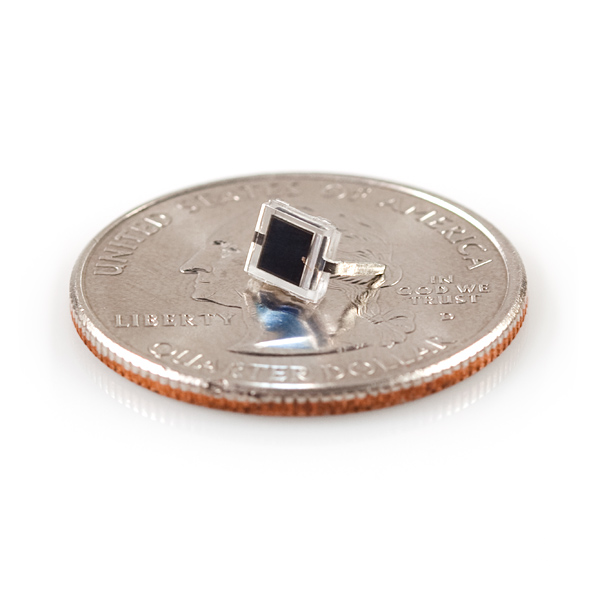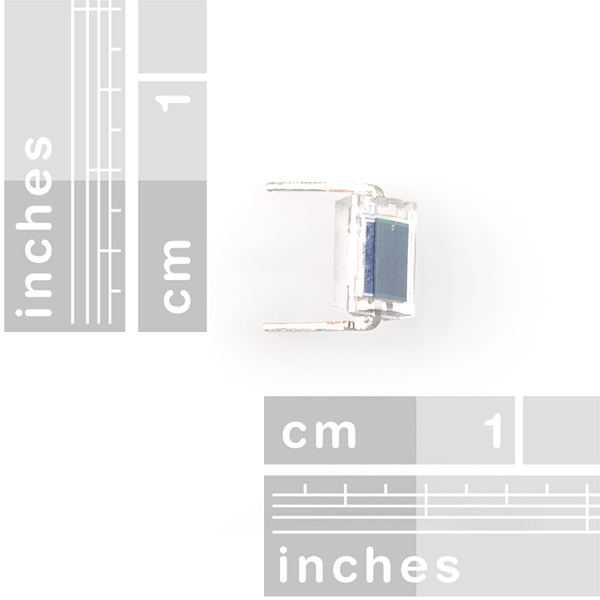The BPW34 is a tiny, general purpose PiN photodiode. This photodiode has a ton of uses, one of which is to use it is a mini solar cell to power small, low power projects. It is also useful when used as a sensor to detect light. The cell is sensitive to a wide range of light wavelengths (430-1100nm), so it should produce power in a number of different settings. The rated open circuit voltage is 350mV (900nm, 1mW/cm2 light source), and short circuit current is 47μA.
These are fun (of course)! We shined a 940nm infrared LED on one of them and it produced about 0.5VDC open circuit voltage. Stringing four together in series, we were able to turn an LED on with them. They'll also produce a small voltage, ~250mV, in a brightly, fluorescent-lit room.
- Package type: leaded
- Package form: top view
- Radiant sensitive area (in mm2): 7.5
- High photo sensitivity
- High radiant sensitivity
- Suitable for visible and near infrared radiation
- Fast response times
- Angle of half sensitivity: phi = ± 65°
- Lead (Pb)-free, RoHS compliant* 5.4x4.3x3.2 mm
Miniature Solar Cell - BPW34 Product Help and Resources
Resources & Going Further
For examples using the BPW34, check out the resources below:
Core Skill: Soldering
This skill defines how difficult the soldering is on a particular product. It might be a couple simple solder joints, or require special reflow tools.
Skill Level: Noob - Some basic soldering is required, but it is limited to a just a few pins, basic through-hole soldering, and couple (if any) polarized components. A basic soldering iron is all you should need.
See all skill levels
Core Skill: Electrical Prototyping
If it requires power, you need to know how much, what all the pins do, and how to hook it up. You may need to reference datasheets, schematics, and know the ins and outs of electronics.
Skill Level: Noob - You don't need to reference a datasheet, but you will need to know basic power requirements.
See all skill levels
Comments
Looking for answers to technical questions?
We welcome your comments and suggestions below. However, if you are looking for solutions to technical questions please see our Technical Assistance page.
Customer Reviews
5 out of 5
Based on 1 ratings:
4 of 4 found this helpful:
Great high-speed light detector
Most light-detection circuits will use a CdS photoresistor like SEN-09088. Unfortunately, they are somewhat slow to react (a few ms). Find for detecting big shadows, but too slow to measure fast-blinking LEDs accurately.
Photodiodes like this product react much more quickly (in the hundreds of ns), so you can get very quick measurements if you have a high-speed ADC (like the MCP3002 (COM-08636 at SparkFun)).




If this is soldered to say a christmas tree light bulb will it light it? If not what else is needed?
Not really. These don't produce much current and are more useful as a light sensor than a power source.
You'd need 200 to 300 of them to light a single LED Christmas tree bulb or roughly 4000 to light a incandescent Christmas tree bulb.
It's way cheaper and easier to use something like our 2 watt solar panel along with an appropriately sized resistor.
OKAY, is this really $1.50 per solar cell?
That is shocking!
Electronic Goldmine had 100 for $20.00!
DANG
I've seen better prices in Sparkfun's history...
Stop complaining. If you want distributor prices, then buy from a distributor and not a retailer. You're paying for the convenience of not having to select your own parts, and for the remarkable reusable red box. By the way, volume discounts are listed above. If these discounts aren't good enough for you, Mouser has them at 100 for $63.30. Were the ones you saw from a reputable manufacturer, or were they just cheap Wun-Hung-Lo knock-offs? By the way, these are not solar cells, they're PIN photodiodes.
Digikey will sell you a single unit for 62 cents, which also -- praise be to cardboard christ! -- includes a box (though not a red one.)
They're not solar cells, despite the title. Solar cells are voltage sources, photodiodes are current sources.
Are the contacts thin enough to fit in a breadboard?
I wonders that too!
Yes.
do the pins manage to get over the trench? (the space in the middle of the breadboard(I like calling it the trench because I don't know what actually is called))
The datasheet says ~5.1 mm pitch so it would only span 1 hole. It would need to span 2 holes to cross the "trench".
How do you connect these things?
This looks pretty cool, if several of these were storing energy for a while in a capacitor, it might be enough to change an E-ink display.
By the way, any chance SparkFun will be getting E-ink displays in the future? That would be awesome!
They have them now! Rejoice!
We've seen a lot of these cells over the years, and there are different versions. YES, Electronic goldmine has had some, but they're not the same quality as real BPW-34 units.
Remember, a solar array is only as strong as the weakest in the link...
I don't know about electronics goldmine, but I've purchased these cells for $0.87 each (.699 for 10) from digikey, and i've purchased them from solarbotics (at $1.00 each), they are the same.
This isn't a bad price, DigiKey has them for 1.52 so I see no reason to complain regarding pricing...just saying, besides, I'd rather give my money to a company that is giving back to the community...
how meny volts would i get out of it if i point a 5mw red laser and would i just multiply that by how meny lasers?
Probably close to zero, and no.
If I'm understanding this correctly, this could be considered a tiny solar cell or a large photodiode. My question is, would this be more sensitive to light than the basic photodiode SparkFun sells? I'm looking for something that will pick up amber light to trigger a buzzer.
Interesting fact, solar irradiance maxes out at around 1366 watts per square meter, and this solar cell is 1 / 133,333 square meters, so that comes out to a solar input of 10.2mW of power on that tiny little diode, which causes it to put out 16.5uW of electrical power, so it has an efficiency of 1.6%.
Pretty cool if we had much higher efficiency cells, getting that much power from that small of a space. Gotta love the sun!
Good calculation, except the 1350 watts per square meter is what you'll see at earth's distance from the sun, out in space (above the atmosphere). The most we'll see at the surface is on the order of 1000W, and typically it's more like 750. But you're right, it's a neat little part!
This can also be used as an inexpensive radiation detector. See Elektor magazine, June 2011.
Make magazine just used a bunch of these with a joule thief to make an LED light up on a bracelet.
Can be usefull for energy harvesting aplications like using the LTC3108 IC that can get as low as 20mV of input voltage and turn it into a usefull voltage for charging battery or a supercapacitor for using in low power aplications like wireless sensor networks. http://www.femtogen.com has a nice board using that ic
can these be tied together to make up to a 12v or 18v feed?
Yes you will have to put about... 20 cells for the 12v and 35 for the 18v. Remember though I over estimated at getting power from a certain cell at 250mv so that way you won't need full bright sunlight. Also remember to put them in series not parallel( series means kind of like taking a battery and putting one right after it and so on. Parallel means you kind of take a battery and take another battery however many you wants and tying all the + together and same for -.
(sorry im new to this)so about how many of these will i need to get 1v on a sunny day
I'd say about 3, as they're rated at 350mV (0.35V) each. Pop them together in series, you've got 1050mV (1.05V). To be safe, it wouldn't hurt to add a fourth to make sure you're really getting the 1V you need (4x350mV=1400mV=1.4V).
For the people who may interested: (and certainly now with Japan's Problems)
You can use this to make a miniature Radiaton Detector. Below is a link with a cool project using one of these PIN-Diodes. Haven't tried building it yet, because I don't have a suitable keyfob enclosure. And also, because it looks very hard to build. Parts are on the other hand very easy to get by. Maybe first build a bigger handheld-type before applying nanotechnology :)
http://www.techlib.com/area_50/enricosprojects.htm#Worlds Smallest
Edit: Those NukAlert thingies (which cost $160) use the same principle.
I put 10 of these in parallel and got about .4V in a fluorescent lit room but I didn't get a chance to test it in the sun. Resistance was about 3.31K ohms
I put 10 in series and got about 5V at mid day sun, and about 3.2V in a fluorescent lit room. Resistance was about 15K ohms.
Either way not powerful enough to make an LED bright, only make the diode flutter ever so slightly.
Ahhh, the irony of powering a light with solar power. :o)
I don't know why this is being marketed as a solar cell. It's not... It's a photodiode.
They're the same thing. A solar cell is a large photodiode used in a mode where bias current is not applied.